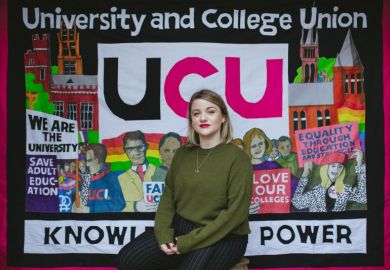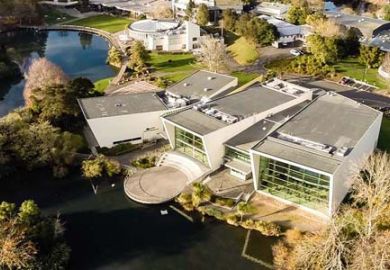To mark its 75th anniversary, Utah Valley University (UVU) unveiled a 200ft-wide (60 metres) stained-glass mural at its library.
The 80-pane panorama, titled Roots of Knowledge, chronicles the greatest advances of human civilisation, illustrating major events and inventions from the Mayan calendar to the US civil rights movement. It combined the work and guidance of more than 40 professional artists, 26 scholars and 350 students.
Matthew Holland, UVU’s president, told Times Higher Education that the $3 million (£2.42 million) artwork, funded through philanthropy, will be an “engaged learning tool” for students.
But there is also another major reason for the project: to signal to prospective students, the academic community and the public that UVU is a “serious university”.
The institution launched in 1941 as a small vocational school and became a community college in 1987. It was not until 2008 that it became a fully fledged university, and Professor Holland took over the institution a year later.
The stained glass is a “signal that the little vocational school is [now] very vibrant, intellectually alive and yet still a practical university that is moving forward on a grand scale”, he said.
However, Professor Holland said that it was important that the institution retained its community college arm after it was granted university status, even if that made the task of changing the institution’s brand more difficult.
“On the one hand I needed to help the community internally and externally see that this was, and was going to be ever more so, a great serious university; that there were standards [and] we weren’t just some lawned-over state college that did vocational training,” he said.
“One of the easiest ways to do that would be to hive off all of the vocational training and say that we don’t do that any more. But I knew that we needed to hang on to that, that it was an important part of our model, a way to help save costs, and a way to create opportunities for students that need them.”
Implementing this “dual mission” of being both a community college and a university has helped the institution to reduce tuition and fees to an average of $14,802 a year and increase enrolment to almost 35,000 students at a time when other US universities are hiking costs and struggling with recruitment, according to Professor Holland.
He said that this low-cost model is a direct response to what he calls the “ironic state of higher education”: the public questioning the value and relevance of universities as technological advancements and increasing globalisation mean that degrees are needed more than ever.
The community college part of the institution has open admissions, meaning that all students who apply will be given a place, while the university has structured enrolment, which requires students to achieve a certain grade point average and entrance test score to begin at undergraduate or master’s level. However, those students who do not pass these thresholds are still offered a place to study on a two-year associate degree or certificate programme, after which they can progress to the university and transfer their credits with no additional costs.
A key decision has been to not introduce “very expensive” PhD programmes or focus on “major research” in order to keep down costs, he said, noting that more than 30 per cent of students at the university work more than 31 hours a week during their studies, 22 per cent support at least one child and 36 per cent are the first in their family to go to college.
This means that faculty are entirely focused on teaching and conduct research only if it involves undergraduates.
Another big, and controversial, choice was to introduce soccer instead of American football – which often involves expensive facilities – to prevent a dramatic increase in student fees.
In order to remain relevant, Professor Holland said that the curriculum is “hands-on, applied and practical”, designed with input from industry, and includes opportunities to work with local businesses and cities on public projects. Degree programmes are tied to regional needs, such as automation and robotics technology, cybersecurity and animation.
“We’re trying to build our programmes where our students are getting jobs so there’s this direct relevance,” he said. “That’s even true at the graduate level.”
He admitted that this model should not be introduced at all US universities – “there still needs to be the Harvards and the MITs [Massachusetts Institute of Technology] of the world” – but believes that the strategy is one way of resolving higher education’s funding “crisis”.
“The key is we’re one system, with one set of buildings, one set of faculty, one set of staff, and we can address all the needs the students have for the workforce development in our area,” he said.
POSTSCRIPT:
Print headline: UVU ‘dual mission’ aims to ease funding woes
Register to continue
Why register?
- Registration is free and only takes a moment
- Once registered, you can read 3 articles a month
- Sign up for our newsletter
Subscribe
Or subscribe for unlimited access to:
- Unlimited access to news, views, insights & reviews
- Digital editions
- Digital access to THE’s university and college rankings analysis
Already registered or a current subscriber? Login




